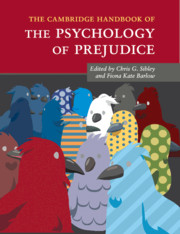Book contents
- Frontmatter
- Dedication
- Contents
- List of Figures
- List of Tables
- Notes on the Contributors
- Part I General Theoretical Perspectives
- Part II Prejudice in Specific Domains
- Part III Prejudice Reduction and Analysis in Applied Contexts
- 20 Recent Developments in Intergroup Contact Research: Affective Processes, Group Status, and Contact Valence
- 21 From Prejudice Reduction to Collective Action: Two Psychological Models of Social Change (and How to Reconcile Them)
- 22 Self-Regulation Strategies for Combatting Prejudice
- 23 Antecedents and Consequences of Evaluative Concerns Experienced During Intergroup Interaction: When and How Does Group Status Matter?
- 24 Stereotypicality Biases and the Criminal Justice System
- 25 Prejudice, Stigma, Bias, Discrimination, and Health
- 26 Development of Delegitimization and Animosity in the Context of Intractable Conflict
- 27 Interventions in Real-World Settings: Using Media to Overcome Prejudice and Promote Intergroup Reconciliation in Central Africa
- 28 Identification with All Humanity: The Antithesis of Prejudice, and More
- 29 It's All About Ignorance: Reflections from the Blue-eyed/Brown-eyed Exercise
- Index
- References
22 - Self-Regulation Strategies for Combatting Prejudice
from Part III - Prejudice Reduction and Analysis in Applied Contexts
Published online by Cambridge University Press: 17 November 2016
- Frontmatter
- Dedication
- Contents
- List of Figures
- List of Tables
- Notes on the Contributors
- Part I General Theoretical Perspectives
- Part II Prejudice in Specific Domains
- Part III Prejudice Reduction and Analysis in Applied Contexts
- 20 Recent Developments in Intergroup Contact Research: Affective Processes, Group Status, and Contact Valence
- 21 From Prejudice Reduction to Collective Action: Two Psychological Models of Social Change (and How to Reconcile Them)
- 22 Self-Regulation Strategies for Combatting Prejudice
- 23 Antecedents and Consequences of Evaluative Concerns Experienced During Intergroup Interaction: When and How Does Group Status Matter?
- 24 Stereotypicality Biases and the Criminal Justice System
- 25 Prejudice, Stigma, Bias, Discrimination, and Health
- 26 Development of Delegitimization and Animosity in the Context of Intractable Conflict
- 27 Interventions in Real-World Settings: Using Media to Overcome Prejudice and Promote Intergroup Reconciliation in Central Africa
- 28 Identification with All Humanity: The Antithesis of Prejudice, and More
- 29 It's All About Ignorance: Reflections from the Blue-eyed/Brown-eyed Exercise
- Index
- References
Summary
In September 2013, police shot and killed Jonathan Ferrell as they responded to a call about a possible breaking and entering in a Charlotte, North Carolina, neighborhood (King & Stapleton, 2013). Jonathan had been in a serious car accident and sought help after escaping the car through the back window. When he approached a nearby home, the homeowner called 911 and reported that Jonathan was trying to break in. When the police arrived, Jonathan ran toward them, likely disoriented and seeking assistance for his injuries. As he approached, he was shot and killed by an officer on the scene. Why were the homeowner and police officers so quick to assume that Jonathan was dangerous? Would the evening have ended differently if Jonathan were not a young, Black man? Perhaps. The evaluations and judgments of the officers and homeowner were potentially swayed by the subtle but powerful influence of racial biases.
Despite the decline in overtly hostile and blatant forms of racial prejudice since the civil rights movement in the United States, subtle forms of bias remain widespread with pervasive consequences. Data from Project Implicit, an online demonstration website assessing people's implicit biases, shows that on average people visiting the website demonstrate significant anti-Black bias on a race implicit association task (Nosek, Banaji, & Greenwald, 2002). People also show implicit biases related to other racial groups and based on gender, religion, and age (Axt, Ebersole, & Nosek, 2014; Nosek et al., 2002). These widely held implicit biases can become activated automatically, without a person's awareness or intention, and can meaningfully influence people's evaluations and judgments. For example, as implicit racial bias increased, White doctors were less likely to treat Black patients presenting with symptoms of a heart attack with a potentially life-saving treatment to reduce blood clots (Green et al., 2007). In addition, once activated, these subtle biases can influence the people's responses regardless of their levels of explicit, consciously endorsed prejudice. Even people who sincerely endorse egalitarian beliefs and believe themselves to be non-prejudiced may possess and be swayed by subtle biases (e.g., Devine, 1989).
If these biases are widely held and influence people's thoughts, feelings, and actions, how can people combat them? Their biases may conflict with social norms and/or their internal standards. If people remain unaware that their thoughts, feelings, and behaviors are inconsistent with personal and societal standards, the bias will live on, unchallenged and unchecked.
- Type
- Chapter
- Information
- The Cambridge Handbook of the Psychology of Prejudice , pp. 500 - 518Publisher: Cambridge University PressPrint publication year: 2016
References
- 1
- Cited by



